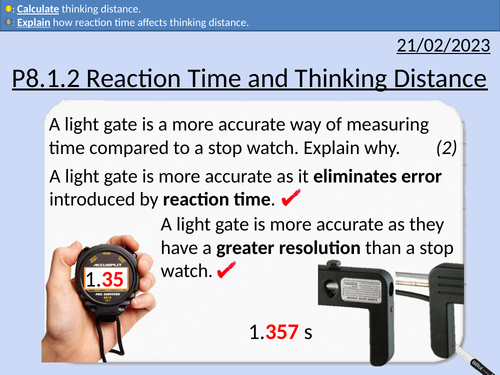
This presentation covers OCR Gateway Physics 9-1 P8.1.2 Reaction Time and Thinking Distance. All presentations come with student activities and worked solutions.
- Reaction time definition
- Factors that increase reaction time
- Simple reaction time experiment
- Thinking distance
- Rearranging equations
- Speed equation
- (Final velocity)2 – (Initial velocity)2 = 2 x Acceleration x Distance
- v2 – u2 = 2 a s
Get this resource as part of a bundle and save up to 20%
A bundle is a package of resources grouped together to teach a particular topic, or a series of lessons, in one place.
GCSE OCR Physics: P8 Global Challenges
All resources for P8 Global Challenges GCSE OCR Physics Gateway 9-1. Triple and combined (Higher and Foundation) is covered in this material. * Average speeds of walking, running, cycling, cars, trains, wind, sound, and light. * The speed equation * The acceleration equation * Explaining average speed camera * Explaining instantaneous speed camera * Estimating everyday accelerations * Calculating speed from rotation speed and circumference of wheels * Converting from miles per hour to meters per second * Reaction time definition * Factors that increase reaction time * Simple reaction time experiment * Thinking distance * Rearranging equations * Speed equation * (Final velocity)2 – (Initial velocity)2 = 2 x Acceleration x Distance * v2 – u2 = 2 a s * Factors affecting braking distance * Total stopping distances * Calculating area of a velocity-time graph for displacement (distance traveled). * Rearranging equations * MOT testing * Large accelerations produce large forces. * Values of g that cause severe injury or death * Road Safety * Newton’s First Law and seat belts * Crumple zones * Force = Mass x Acceleration * Acceleration = Change in velocity /Time taken * Estimating speed, accelerations and forces involved in large accelerations for everyday road transport. * Types of different energy sources * Renewable and non-renewable definitions * Different uses of energy sources - transport, heating, and generating electricity * Advantages and disadvantages of different energy sources * Fossil fuels – oil, coal, and natural gas. * Nuclear fuel – Uranium * Biofuels – wood, biodiesel, and biogas. * The sun - solar (PV) panels and solar heating panels * Tides * Waves * Hydroelectricity * Wind * Geothermal * How use of energy resources have changed over time. (Biofuels, Fossil Fuels, Nuclear, Renewable). * How energy use has increased (increase population and development of technology) * Explain patterns and trends in the use of energy resources. * Fossil fuels are finite and will run out at current consumption levels. * Structure of the National Grid * Step-up and Step-down transformers * How transformers increase the efficiency of the National Grid * Number of turns and potential difference * Current and potential difference in primary and secondary coils * Domestic Electrical Supply being 230 V, AC at 50 Hz. * Direct potential difference and alternating potential difference. * Reasons for insulation on wires. * Potential Difference between different conductors. * Function of the earth conductor. * Double insulation and no earth wire. * Reasons the live wire is dangerous. * Reasons why live to earth is dangerous. * Key facts about the Big-Bang model * Cosmic Microwave Background (CMB, CMBR) * Doppler Red shift of light from stars in galaxies * Hubble’s evidence of absorption spectra being red shifted * Structure of the solar system * Nuclear Fusion * Evolution of large stars * Evolution of Sun like stars * Gravitational force and force from nuclear fusion * Natural Satellites * Geostationary Satellites * Low Polar Orbit Satellites * Speed is constant and velocity is changing in stable orbits. * Changing speed and radius * Gravitational force, acceleration, and speed. * Plotting data and describing relationships * All objects emit electromagnetic radiation * Describe how changing temperature changes frequency, wavelength, and intensity of the radiation produced. * Explain why objects change temperature by absorbing and emitting radiation. * Explain why the temperature of the Earth changes due to greenhouse gases in the atmosphere. * S and P waves * Structure of the Earth * Reflection, absorption, and refraction of waves * Sonar to map the ocean floor
GCSE OCR Physics: P8.1 Physics on the move
All resources for P8.1 Physics on the move GCSE OCR Physics Gateway 9-1. Triple and combined (Higher and Foundation) is covered in this material. * Average speeds of walking, running, cycling, cars, trains, wind, sound, and light. * The speed equation * The acceleration equation * Explaining average speed camera * Explaining instantaneous speed camera * Estimating everyday accelerations * Calculating speed from rotation speed and circumference of wheels * Converting from miles per hour to meters per second * Reaction time definition * Factors that increase reaction time * Simple reaction time experiment * Thinking distance * Rearranging equations * Speed equation * (Final velocity)2 – (Initial velocity)2 = 2 x Acceleration x Distance * v2 – u2 = 2 a s * Factors affecting braking distance * Total stopping distances * Calculating area of a velocity-time graph for displacement (distance traveled). * Rearranging equations * MOT testing * Large accelerations produce large forces. * Values of g that cause severe injury or death * Road Safety * Newton’s First Law and seat belts * Crumple zones * Force = Mass x Acceleration * Acceleration = Change in velocity /Time taken * Estimating speed, accelerations and forces involved in large accelerations for everyday road transport.
Something went wrong, please try again later.
This resource hasn't been reviewed yet
To ensure quality for our reviews, only customers who have purchased this resource can review it
Report this resourceto let us know if it violates our terms and conditions.
Our customer service team will review your report and will be in touch.
